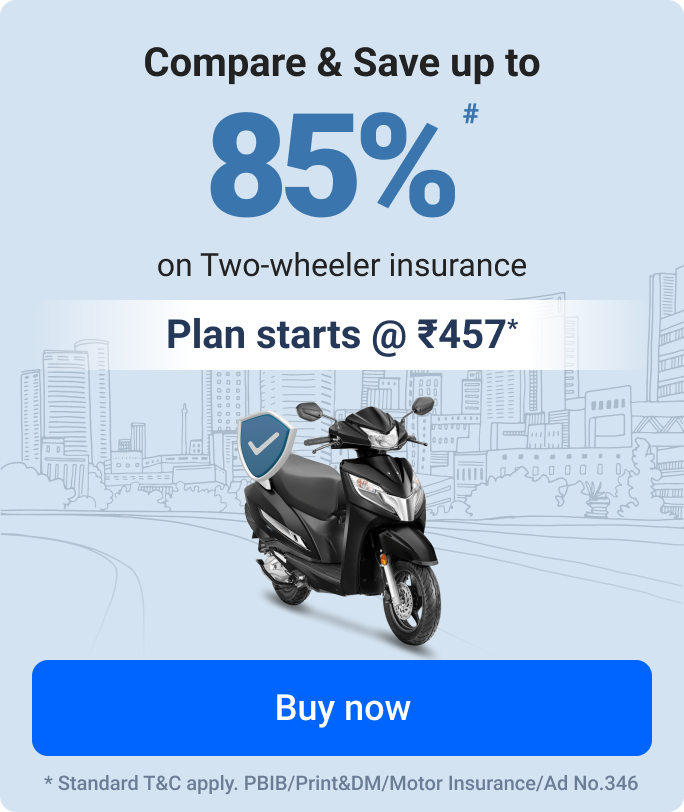Factors Affecting Two-wheeler Insurance Purchase
Having a motorbike has become a necessity. As a bike owner, you must protect it with two wheeler insurance from any unwanted circumstances. However, several factors impact your two-wheeler insurance purchase. So, you must know these factors before buying an insurance policy for your bike. Read on this article to get updated with these factors to make the right decision.
10 Factors Impacting Your Two-wheeler Insurance Purchase
India is the world's largest two-wheeler market and many two-wheeler companies are selling different variants and models of bikes. If you are planning to buy a new bike, you must consider various factors affecting your two-wheeler insurance online purchase. Also, you must know how insurance companies calculate a premium to get the best deal.
-
Type of Insurance Plan
There are two types of two-wheeler insurance available for bike owners, i.e.- third party bike insurance and comprehensive insurance plan. The premium amount for third-party insurance is decided by the IRDAI, and the comprehensive plan is decided by the insurer. However, the premium of third-party cover is lower than comprehensive cover.
Under this comprehensive cover, third-party liability, as well as own damages (OD), are covered. Also, buying a long-term insurance plan costs you lower than an annual insurance plan.
-
Model and Make
The manufacture year and model are two obvious factors that influence the bike insurance premium rate. If you have a basic bike model, the premium cost will be less, whereas the premium price will rise if you own a premium or sports bike. Moreover, the bike's age is also considered while calculating the premium amount.
That is why while purchasing bike insurance renewal, you have to enter the manufacturing year of your bike on the insurer's website. Always keep in mind any new bike means a higher premium, while an old or second-hand bike means a comparatively lesser premium.
-
Engine's Capacity
Another important factor that impacts your two-wheeler insurance premium amount is the engine capacity of your bike. It is considered that if the engine capacity of your bike is less than 75 CC (cubic capacity), you will pay a lower premium. Whereas if your bike's engine capacity is more than 350 CC, the premium amount will automatically rise.
-
Modification and Beautification
Usually, bikers love to modify their bikes to enhance their performance and appearance. But do they know a single modification increases the premium price? By modifying or beautifying your two-wheel buddy, your insurance price also rises. As each added or modified part in your bike needs to be insured separately.
-
IDV
IDV in insurance policy stands for Insured Declared Value. It is the promised maximum amount your insurer will pay at the time of total loss or theft of your bike. The calculation of IDV is done with the help of the computation of depreciation each year during the renewal. With each year passing, your bike's value depreciates, and thus, the IDV also comes down & plays a vital role in deciding your insurance premium.
-
No Claim Bonus (NCB)
No Claim Bonus (NCB) is a discount offered in the form of a bonus by the insurance company to the policyholder for not raising a single claim in the policy period. This discount is a reward for riding safely and therefore not raising claims for the damages. In this, you can accumulate a discount on a premium of up to 50% for five consecutive claim-free years.
-
Add-on Covers
Add-on covers are extra coverage given to enhance your basic comprehensive bike insurance. These covers can be purchased by paying an extra premium amount. There are several add-on covers that you can buy including, road assistance cover, NCB protection cover, zero depreciation cover, consumables cover, etc.
-
Rider's Driving History
Your insurance company will also consider other factors like the riding experience of the driver, age of the driver, and previous driving history to determine the premium amount based on the risk.
For example- young riders falling in the age group category of 20-25 years with a driving experience of less than one year may be charged an extra premium compared to experienced and middle-aged riders.
-
Anti-theft Device Installation
Installing an anti-theft device or lock or GPS certified by the Automotive Research Association of India (ARAI) will lower the insurance premium amount. After all, these devices will reduce the chances of theft, thus lowering the risk, and ultimately, it will lessen the premium amount.
-
Increase the Voluntary Deductibles
There are two types of deductibles available in a two-wheeler insurance policy. Compulsory deductibles are fixed, and they cannot be increased or decreased. Under this, you pay a fixed percentage of the amount for the repair cost from your pocket, and the rest your insurer will pay.
On the other hand, voluntary deductibles are the unfixed amount that you can adjust when purchasing your two-wheeler insurance policy. In case you choose higher voluntary deductibles, your premium amount can be lower. However, increasing your voluntary deductibles means paying more money from your pocket when the bike is damaged.
Purchasing Two-wheeler Insurance Online
Purchasing two-wheeler insurance online is quite a simple process. There are several two-wheeler insurance companies as well as insurance companies that offer you different coverage at different prices for different bike models.
By purchasing a two-wheeler insurance policy online, you can effectively do the premium calculation and compare them with others to get the best value for money. Also, you can check the policy benefits, exclusions, and talk to the insurance executive before making payment.
Summarizing
A two-wheeler insurance policy provides you coverage by paying a premium amount. Consider the above-mentioned factors while buying a two-wheeler insurance policy to lower your premium amount and avail the maximum coverage.
^The renewal of insurance policy is subject to our operations not being impacted by a system failure or force majeure event or for reasons beyond our control. Actual time for a transaction may vary subject to additional data requirements and operational processes.
^The buying of Insurance policy is subject to our operations not being impacted by a system failure or force majeure event or for reasons beyond our control. Actual time for transaction may vary subject to additional data requirements and operational processes.
#Savings are based on the comparison between highest and the lowest premium for own damage cover (excluding add-on covers) provided by different insurance companies for the same vehicle with the same IDV and same NCB.
*TP price for less than 75 CC two-wheelers. All savings are provided by insurers as per IRDAI-approved insurance plan. Standard T&C apply.
*Rs 538/- per annum is the price for third party motor insurance for two wheelers of not more than 75cc (non-commercial and non-electric)
#Savings are based on the comparison between the highest and the lowest premium for own damage cover (excluding add-on covers) provided by different insurance companies for the same vehicle with the same IDV and same NCB.
*₹ 1.5 is the Comprehensive premium for a 2015 TVS XL Super 70cc, MH02(Mumbai) RTO with an IDV of ₹5,895 and NCB at 50%.
*Rs 457/- per annum is the price for the third-party motor insurance for private electric two-wheelers of not more than 3KW (non-commercial).The list of insurers mentioned are arranged according to the alphabetical order of the names of insurers respectively.Policybazaar does not endorse, rate or recommend any particular insurer or insurance product offered by any insurer. The list of plans listed here comprise of insurance products offered by all the insurance partners of Policybazaar. For complete list of insurers in India refer to the Insurance Regulatory and Development Authority of India website www.irdai.gov.in





























